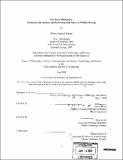| dc.contributor.advisor | Harriet Ritvo. | en_US |
| dc.contributor.author | Benson, Etienne Samuel | en_US |
| dc.contributor.other | Massachusetts Institute of Technology. Program in Science, Technology and Society. | en_US |
| dc.date.accessioned | 2008-11-07T19:17:15Z | |
| dc.date.available | 2008-11-07T19:17:15Z | |
| dc.date.copyright | 2008 | en_US |
| dc.date.issued | 2006 | en_US |
| dc.identifier.uri | http://hdl.handle.net/1721.1/43219 | |
| dc.description | Thesis (Ph. D. in History, Anthropology, and Science, Technology and Society (HASTS))--Massachusetts Institute of Technology, Program in Science, Technology and Society, 2006. | en_US |
| dc.description | Includes bibliographical references. | en_US |
| dc.description.abstract | In the second half of the twentieth century, American wildlife biologists incorporated Cold War-era surveillance technologies into their practices in order to render wild animals and their habitats legible and manageable. One of the most important of these was wildlife radio-tracking, in which collars and tags containing miniature transmitters were used to locate individual animals in the field. In addition to producing new ecological insights, radio-tracking served as a site where relationships among scientists, animals, hunters, animal rights activists, environmentalists, and others involved in wildlife conservation could be embodied and contested. While scholars have tended to interpret surveillance technologies in terms of the extension of human control over nature and society, I show how technological, biological, and ecological factors made such control fragmentary and open to reappropriation. Wildlife radio-tracking created vulnerabilities as well as capabilities; it provided opportunities for connection as well as for control. I begin by showing how biologists in Minnesota and Illinois in the early 1960s used radio-tracking to establish intimate, technologically-mediated, situated relationships with game animals such as ruffed grouse, which they hoped would bolster their authority vis-a-vis recreational hunters. I then show how the technique was contested by environmentalists when biologists applied it to iconic "wilderness wildlife" such as grizzly bears in Yellowstone National Park in the 1960s and 1970s. One way for biologists to render radio-tracking acceptable in the face of such opposition was to emphasize its continuity with traditional practices, as they did in a radio-tagging study of tigers in Nepal in the 1970s. | en_US |
| dc.description.abstract | (cont.) Another way was to shift to less invasive techniques of remote sensing, such as the bioacoustic surveys of bowhead whales off Alaska's Arctic coast that were conducted in the 1980s after a proposal to radio-tag whales was rejected by marine mammalogists and Ifiupiat whalers. Finally, wildlife biologists could reframe radio-tracking as a means for popular connection rather than expert control, as they did by broadcasting the locations of satellite-tagged albatrosses to schoolchildren, gamblers, and the general public via the Internet in the 1990s and early 2000s. | en_US |
| dc.description.statementofresponsibility | by Etienne Samuel Benson. | en_US |
| dc.format.extent | 244 p. | en_US |
| dc.language.iso | eng | en_US |
| dc.publisher | Massachusetts Institute of Technology | en_US |
| dc.rights | M.I.T. theses are protected by
copyright. They may be viewed from this source for any purpose, but
reproduction or distribution in any format is prohibited without written
permission. See provided URL for inquiries about permission. | en_US |
| dc.rights.uri | http://dspace.mit.edu/handle/1721.1/7582 | en_US |
| dc.subject | Program in Science, Technology and Society. | en_US |
| dc.title | The wired wilderness : electronic surveillance and environmental values in wildlife biology | en_US |
| dc.type | Thesis | en_US |
| dc.description.degree | Ph.D.in History, Anthropology, and Science, Technology and Society (HASTS | en_US |
| dc.contributor.department | Massachusetts Institute of Technology. Program in Science, Technology and Society | |
| dc.identifier.oclc | 259204849 | en_US |
